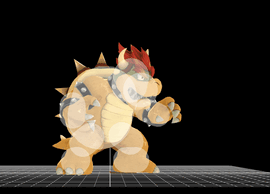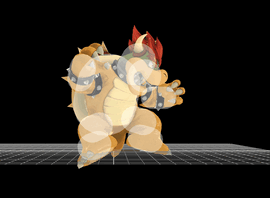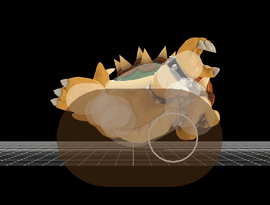Bowser (SSB4)/Side special/Default: Difference between revisions
SuperSqank (talk | contribs) |
SuperSqank (talk | contribs) |
||
| Line 9: | Line 9: | ||
==Update history== | ==Update history== | ||
{{GameIcon|ssb4-3ds}} [[1.0.4]] | '''{{GameIcon|ssb4-3ds}} [[1.0.4]]/{{GameIcon|ssb4-wiiu}} 1.0.0''' | ||
*{{nerf|[[Sacrificial KO]]s using Flying Slam now KO Bowser first instead of the opponent. When Bowser is KO'd, the opponent is released from the grab, potentially allowing them to recover back onto the stage.}} | *{{nerf|[[Sacrificial KO]]s using Flying Slam now KO Bowser first instead of the opponent. When Bowser is KO'd, the opponent is released from the grab, potentially allowing them to recover back onto the stage.}} | ||
{{GameIcon|ssb4}} [[1.0.6]] | {{GameIcon|ssb4}} [[1.0.6]] | ||
*{{buff|Bowser has more control over Flying Slam's trajectory.}} | *{{buff|Bowser has more control over Flying Slam's trajectory, while the opponent has less control (base air acceleration: 0.15 (Bowser)/0.18 (opponent) → 0.18/0.17).}} | ||
{{GameIcon|ssb4}} [[1.1.3]] | {{GameIcon|ssb4}} [[1.1.3]] | ||
*{{buff|Flying Slam's grab to slam transition | *{{buff|Flying Slam's grab to slam transition is considerably faster (38 frames → 25), now only being a few frames slower than its ''Brawl'' counterpart.}} | ||
*{{buff|Bowser has more control over Flying Slam's trajectory (base air acceleration: 0.18 → 0.21).}} | |||
*{{nerf|The opponent has more control over Flying Slam's trajectory (base air acceleration: 0.17 → 0.19).}} | |||
**{{buff|However, this does not fully compensate for Bowser's greater air acceleration, giving him more control overall.}} | |||
*{{buff|All variations of Flying Slam now have invincibility frames before Bowser leaves the ground.}} | *{{buff|All variations of Flying Slam now have invincibility frames before Bowser leaves the ground.}} | ||
Revision as of 12:26, October 27, 2021
Overview
Bowser swings his arm in front of him to grab an opponent. The move is one of Bowser's best neutral options due to its property of being able to auto-cancel upon landing. This allows him to have tricky movement and to end the lag of his bulky aerials, which alleviate Bowser's weaknesses in having to land with the long end lag of his moves. Besides its utility in the neutral, the move boasts as a powerful KO option and can KO opponents at medium-high percents with rage when used on the top platform of common stages such as Battlefield and Smashville. The move provides enough pressure to force the opponent to consider whether or not to shield or to jump. It's a powerful alternative to Bowser's already strong grab and grab game, and due to the move's knockback sending at an upward angle, it can DI mixup an opponent as if they hold in, they do to the top, and if they hold out, they die straight to the side, forcing the opponent to DI down and away, sending them offstage for an edgeguard. It also puts them in the air, giving more opportunity to pressure the opponent and juggle them.
Update history
![]() 1.0.4/
1.0.4/![]() 1.0.0
1.0.0
 Sacrificial KOs using Flying Slam now KO Bowser first instead of the opponent. When Bowser is KO'd, the opponent is released from the grab, potentially allowing them to recover back onto the stage.
Sacrificial KOs using Flying Slam now KO Bowser first instead of the opponent. When Bowser is KO'd, the opponent is released from the grab, potentially allowing them to recover back onto the stage.
 Bowser has more control over Flying Slam's trajectory, while the opponent has less control (base air acceleration: 0.15 (Bowser)/0.18 (opponent) → 0.18/0.17).
Bowser has more control over Flying Slam's trajectory, while the opponent has less control (base air acceleration: 0.15 (Bowser)/0.18 (opponent) → 0.18/0.17).
 Flying Slam's grab to slam transition is considerably faster (38 frames → 25), now only being a few frames slower than its Brawl counterpart.
Flying Slam's grab to slam transition is considerably faster (38 frames → 25), now only being a few frames slower than its Brawl counterpart. Bowser has more control over Flying Slam's trajectory (base air acceleration: 0.18 → 0.21).
Bowser has more control over Flying Slam's trajectory (base air acceleration: 0.18 → 0.21). The opponent has more control over Flying Slam's trajectory (base air acceleration: 0.17 → 0.19).
The opponent has more control over Flying Slam's trajectory (base air acceleration: 0.17 → 0.19).
 However, this does not fully compensate for Bowser's greater air acceleration, giving him more control overall.
However, this does not fully compensate for Bowser's greater air acceleration, giving him more control overall.
 All variations of Flying Slam now have invincibility frames before Bowser leaves the ground.
All variations of Flying Slam now have invincibility frames before Bowser leaves the ground.
 All variations of Flying Slam's grab range increased.
All variations of Flying Slam's grab range increased.
 Grounded grabbox sizes: (4u/3u → 5u/4u (grounded), 1u/1u → 2u/2u (aerial)).
Grounded grabbox sizes: (4u/3u → 5u/4u (grounded), 1u/1u → 2u/2u (aerial)). Far grabbox Z position: (17 → 17.5).
Far grabbox Z position: (17 → 17.5). Aerial grabbox sizes: (5u/3.5u → 6u/4.5u).
Aerial grabbox sizes: (5u/3.5u → 6u/4.5u). Large grabbox Z position: (15 → 15.5).
Large grabbox Z position: (15 → 15.5).
Throw, Grab and Hitbox Data
Ground Grab
| ID | Radius | Bone | Offset | Stretch | G | A | ||||
|---|---|---|---|---|---|---|---|---|---|---|
| 0 | 5.0 | 0 | 0.0 | 8.0 | 17.5 | — | ||||
| 1 | 4.0 | 0 | 0.0 | 8.0 | 11.0 | — | ||||
| 2 | 2.0 | 0 | 0.0 | 8.0 | 17.5 | — | ||||
| 3 | 2.0 | 0 | 0.0 | 8.0 | 11.0 | — | ||||
Air Grab
| ID | Radius | Bone | Offset | Stretch | G | A | ||||
|---|---|---|---|---|---|---|---|---|---|---|
| 0 | 6.0 | 0 | 0.0 | 8.0 | 15.5 | — | ||||
| 1 | 4.5 | 0 | 0.0 | 8.0 | 10.0 | — | ||||
Throw
| ID | Damage | Angle | BK | KS | FKV | Bone | FFx | Type | Effect | Sound | |
|---|---|---|---|---|---|---|---|---|---|---|---|
| 0 | 18% | Forwards | 80 | 60 | 0 | 0 | None | ||||
| 1 | 5% | Forwards | 60 | 30 | 0 | 0 | None | ||||
Collateral
| ID | Part | Damage | SD | Angle | BK | KS | FKV | Radius | Bone | Offset | SDIx | H× | T% | Clang | Rebound | Type | Effect | G | A | Sound | Direct | Stretch | ||||
|---|---|---|---|---|---|---|---|---|---|---|---|---|---|---|---|---|---|---|---|---|---|---|---|---|---|---|
| 0 | 0 | 15% | 1 | 80 | 80 | 0 | 8.0 | 0 | 0.0 | 2.0 | 6.5 | 1x | 1x | 0% | 0.0 | 2.0 | -4.5 | |||||||||
Timing
Ground grab
| Grab | 8 |
|---|---|
| Interruptible | 43 |
| Animation length | 49 |
Air grab
| Grab | 17 |
|---|---|
| Animation length | 48 |
Falling hit
| Intangible | 1-23 |
|---|---|
| Hitbox | 72- |
| Animation length | 81 |
Throw
| Throw | 8 |
|---|---|
| Interruptible | 49 |
| Animation length | 66 |
Lag time |
Hitbox |
Vulnerable |
Intangible |
Grab |
Throw point |
Interruptible |
|


